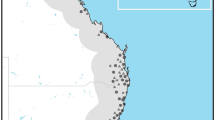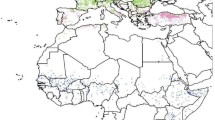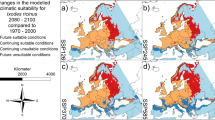Abstract
Climatic changes may lead to drastic changes in the distribution of arthropods important in human health. We tracked changes in habitat suitability for the tick Ixodes ricinus in Europe from 1900 to 1999, using a geographically extensive gridded climate data set. For the whole period, 52% of the territory was always unsuitable for the tick. In the grid, 6.11% of the cells were classified as having a deterministic drift with positive trend and 7.4% as deterministic drift with a negative trend. A total of 17.25% of cells were classified as exhibiting a random walk behavior, with a trend to increase of habitat suitability (9.57%) or decrease (7.68%). Zones of deterministic trend extend into most of Ireland and parts of the United Kingdom and France. Total and summer rainfall primarily drive changes in habitat suitability in these sites. Areas of random walk are common in Scandinavia, central Europe, and the Balkans, with summer rainfall and temperature largely directing the changes. Sites of reported increased abundance of I. ricinus coincided with areas of increased habitat suitability over the last 20–30 years, but this feature showed a long-term random walk negative trend. Habitat suitability for I. ricinus remains relatively stable in Europe, with no sites showing permanent changes in habitat suitability (negative to sustained positive or vice versa). However, some zones in the continent showed a clear trend to increase or decrease.



Similar content being viewed by others
References
Caeiro V (1999) General review of the tick species present in Portugal. Parassitologia 41:11–15
Daniel M, Danielova V, Kriz B, Jirsa A, Nozicka J (2003) Shift of the tick Ixodes ricinus and tick-borne encephalitis to higher altitudes in central Europe. European Journal of Clinical Microbiology & Infectious Diseases 22:327–328
Dickey DA, Fuller WA (1979) Distribution of the estimators for autoregressive time series with a unit root. Journal of American Statistical Association 74:427–431
Estrada-Peña A (2000) Ixodoidea (Acarina) en la Peninsula Ibérica. Fifth Mediterranean Symposium on Ticks and Tick-borne Diseases, University of Madrid (Spain), 119 pp
Estrada-Peña A, Sánchez Acedo C, Quílez J, Del Cacho E (2005) A retrospective study of the climatic suitability for the tick Rhipicephalus (Boophilus) microplus in the Americas. Global Ecology and Biogeography 14:565–573
Estrada-Peña A, Venzal JM, Sánchez Acedo C (2006) The tick Ixodes ricinus (Ixodidae) in western Palaearctic: distribution and ecological preferences. Medical & Veterinary Entomology 20:189–197
Fielding AH, Bell JF (1997) A review of methods for the assessment of prediction errors in conservation presence/absence models. Environmental Conservation 24:38–49
Gilot B (1985) Bases biologiques, écologiques et cartographiques pour l’étude des maladies transmises par les tiques dans les Apes françaises et leur avant-pays. PhD Thesis, University of Grenoble, France, 324 pp
Gray JS (1991) The development and seasonal activity of the tick Ixodes ricinus: a vector of Lyme borreliosis. Review of Medical & Veterinary Entomology 6:323–333
Hargrove WW, Hoffmann F (2005) Potential of multivariate quantitative methods for delineation and visualization of ecoregions. Environmental Management 34:39–60
Hirzel AH, Hausser J, Chessel D, Perrin N (2002) Ecological niche factor analysis: how to compute habitat-suitability mapping without absence data? Ecology 87:2027–2036
Holt RD (1996) Adaptive evolution in source-sink environments: direct and indirect effects of density-dependence on niche evolution. Oikos 75:182–192
Lindgren E, Talleklint L, Polfeldt T (2000) Impact of climatic change on the northern latitude limit and population density of the disease-transmitting European tick Ixodes ricinus. Environmental Health Perspectives 108:119–123
Manilla G (1998) Acari, Ixodida. In: Fauna d’Italia, Vol 36, Calerini (editor), Bologna, Italy, 280 pp
Parmesan C, Yohe G (2003) A globally coherent fingerprint of climate change impacts across natural systems. Nature 421:337–342
Randolph SE, Green RM, Hoodless AN, Peacey MF (2002) An empirical quantitative framework for the seasonal population dynamics of the tick Ixodes ricinus. International Journal of Parasitology 32:979–989
Root TL, Price JT, Hall KR (2003) Fingerprints of global warming on wild animals and plants. Nature 421:57–60
Siuda K (1987) Studies of ticks (Acari: Ixodida) in Poland. Wiad Parazytologia 33:9–24
Swets JA (1988) Measuring the accuracy of diagnostic systems. Science 240:1285–1293
Talleklint L, Jaenson TG (1998) Increasing geographical distribution and density of Ixodes ricinus (Acari: Ixodidae) in central and northern Sweden. Journal of Medical Entomology 35:521–526
Acknowledgments
This article used the CRU TS 1.2 climate time series, developed in the Tyndall Centre for Climate Change Research by T.D. Mitchell.
Author information
Authors and Affiliations
Corresponding author
Rights and permissions
About this article
Cite this article
Estrada-Peña, A., Venzal, J.M. Changes in Habitat Suitability for the Tick Ixodes ricinus (Acari: Ixodidae) in Europe (1900–1999). EcoHealth 3, 154–162 (2006). https://doi.org/10.1007/s10393-006-0036-6
Published:
Issue Date:
DOI: https://doi.org/10.1007/s10393-006-0036-6




